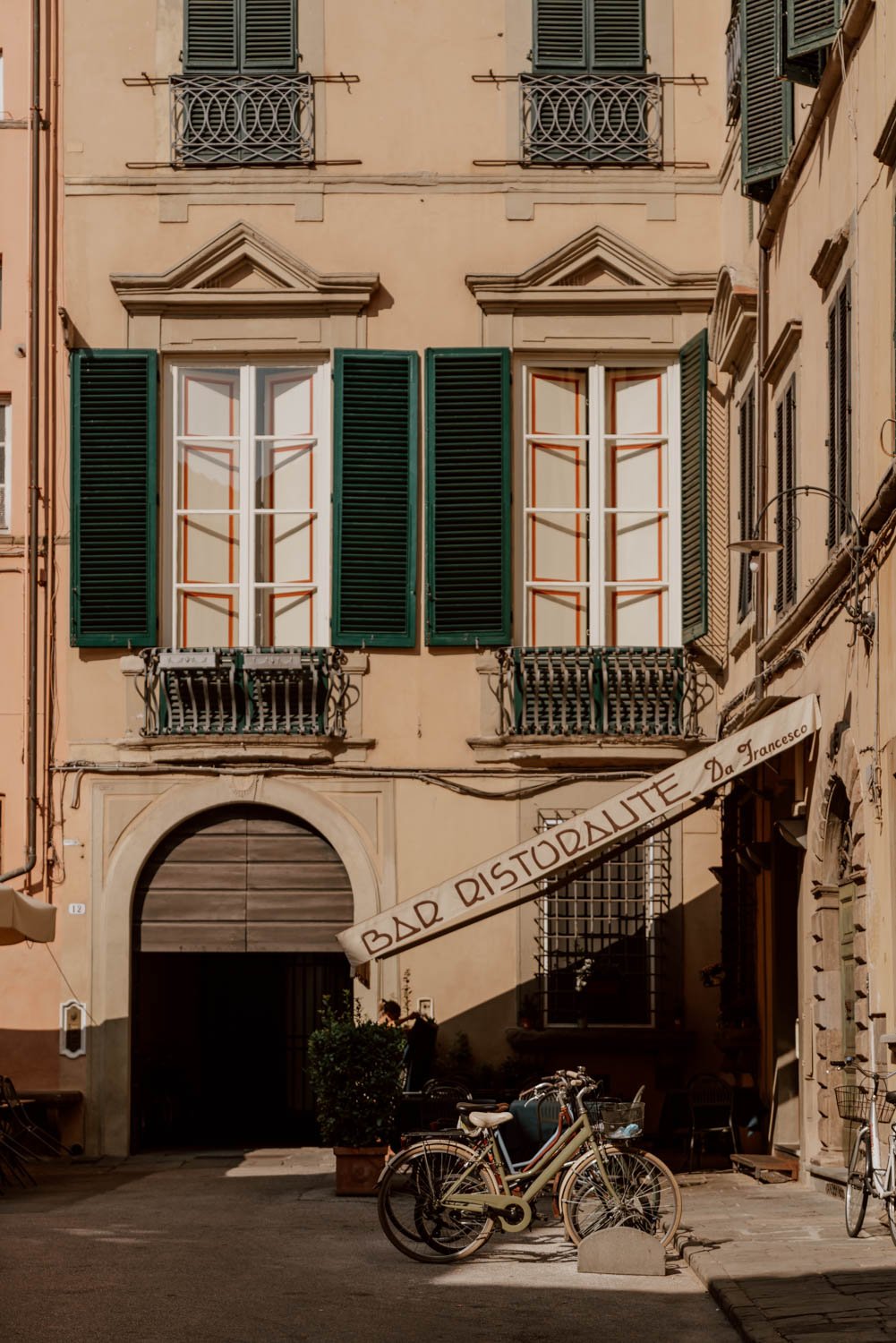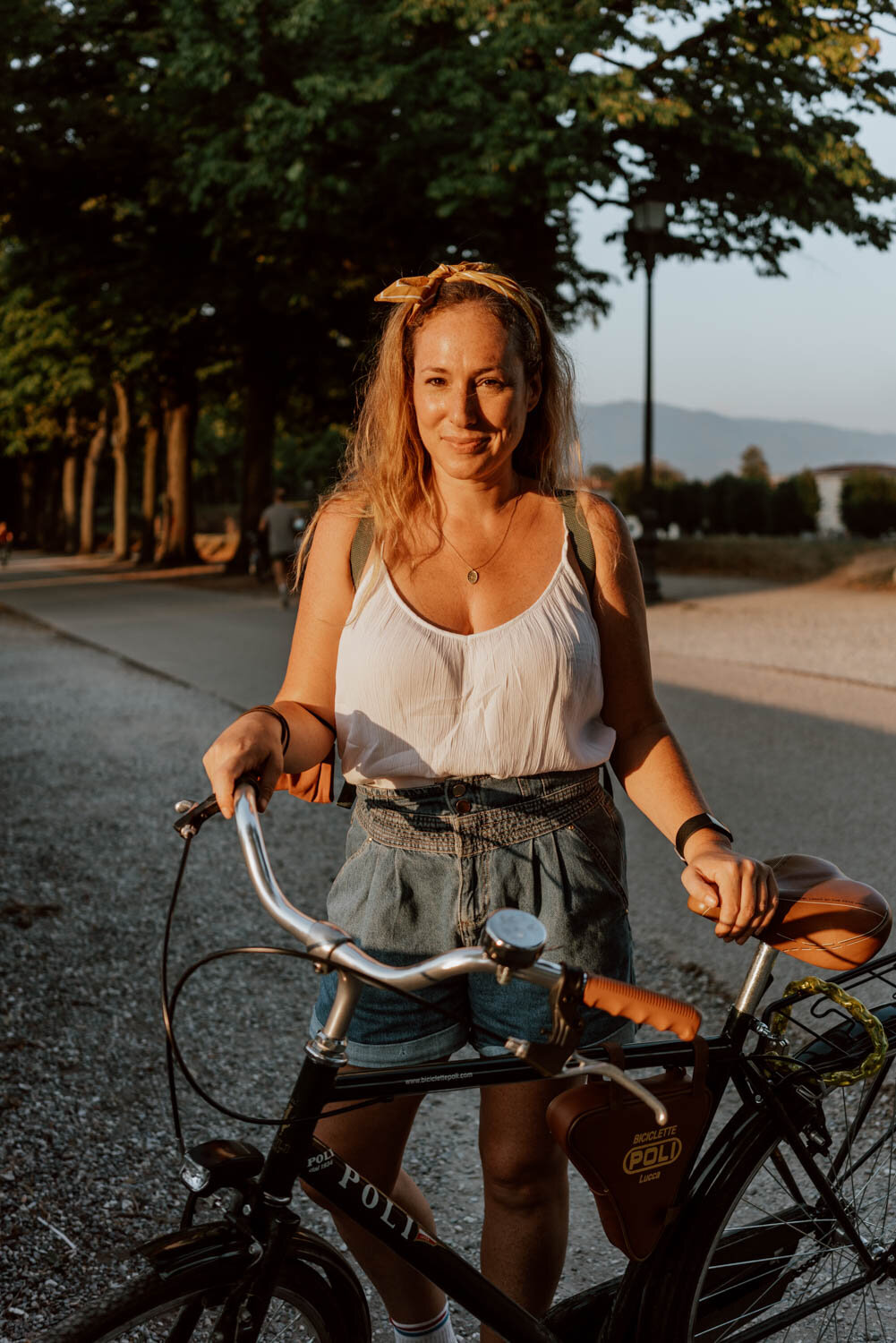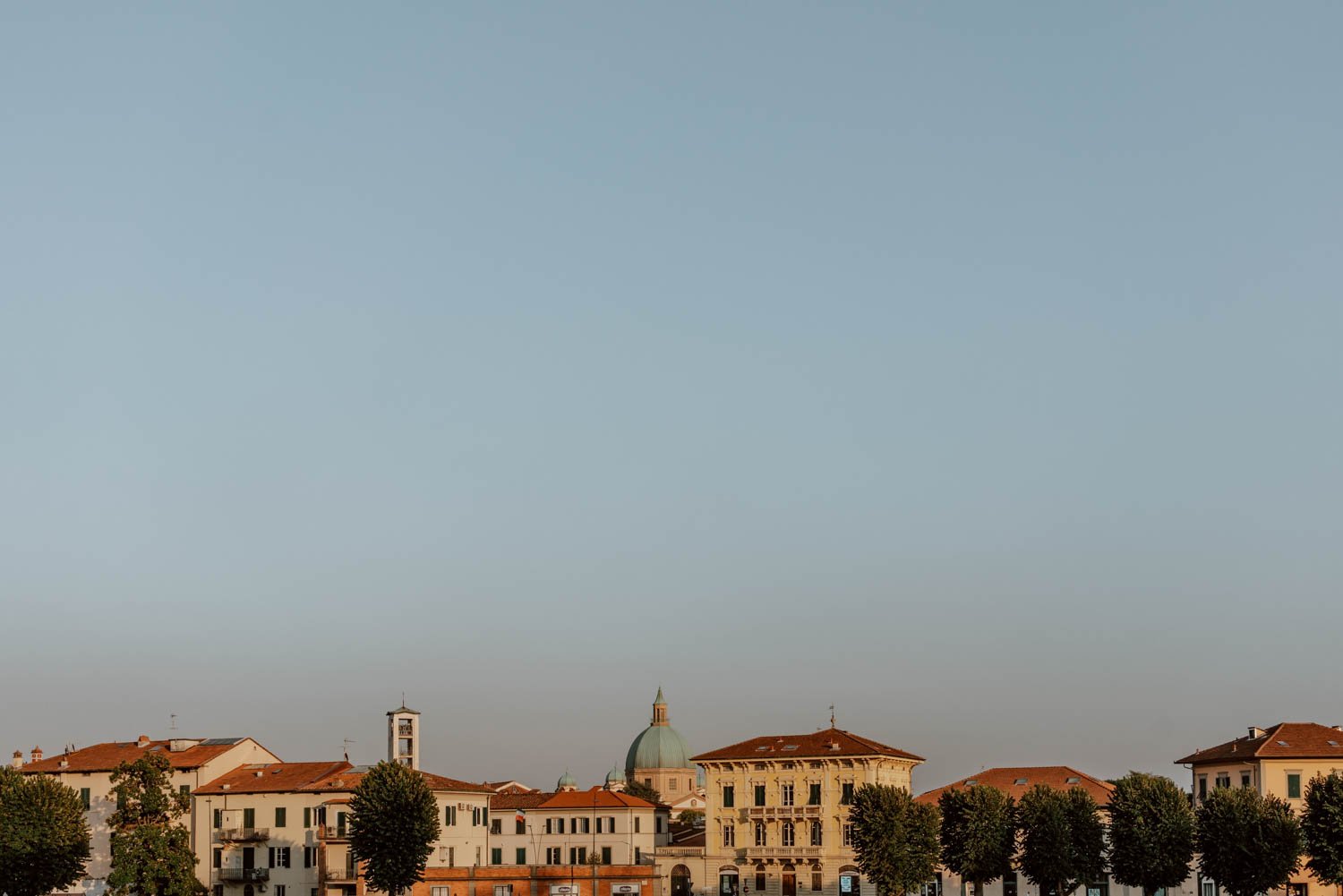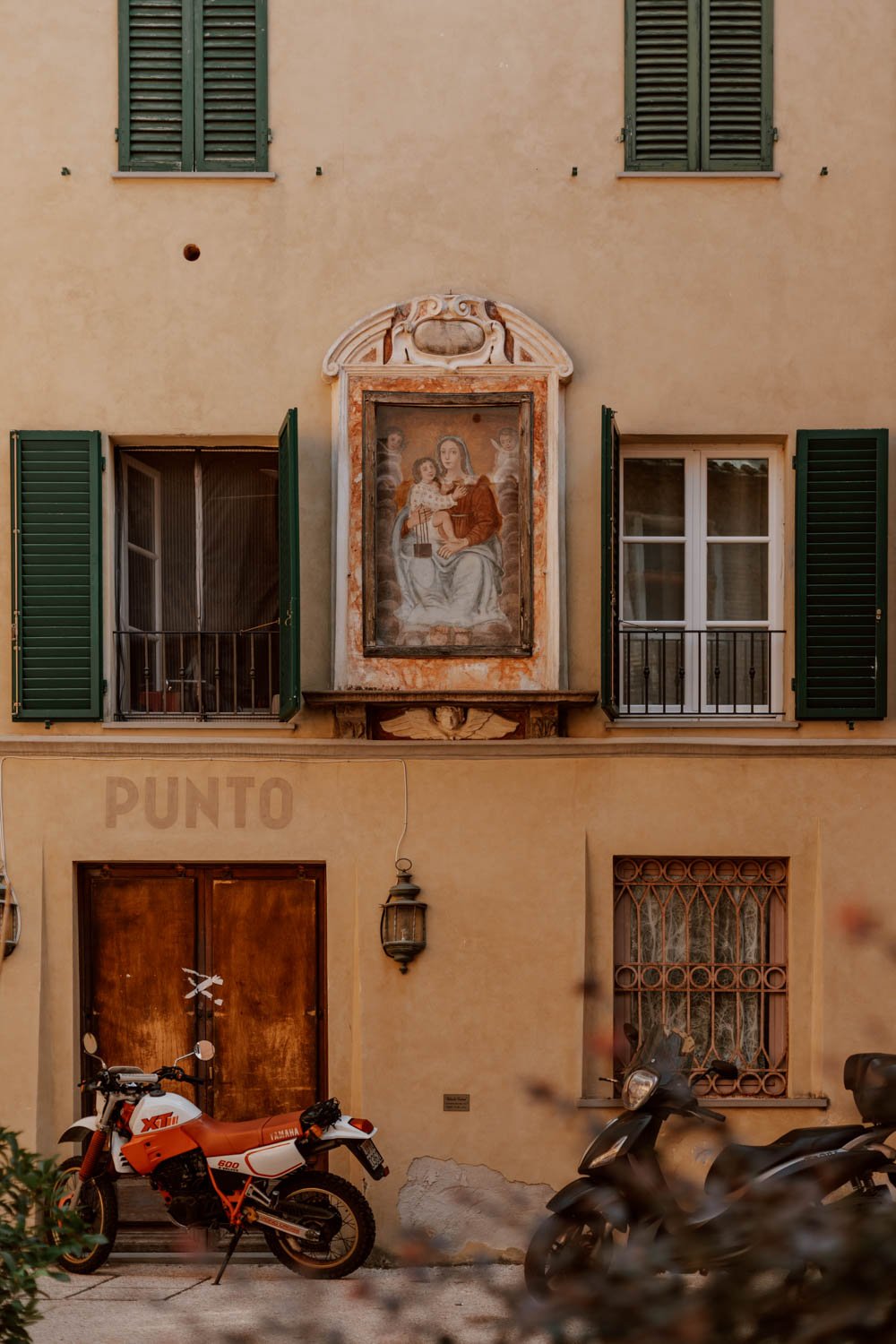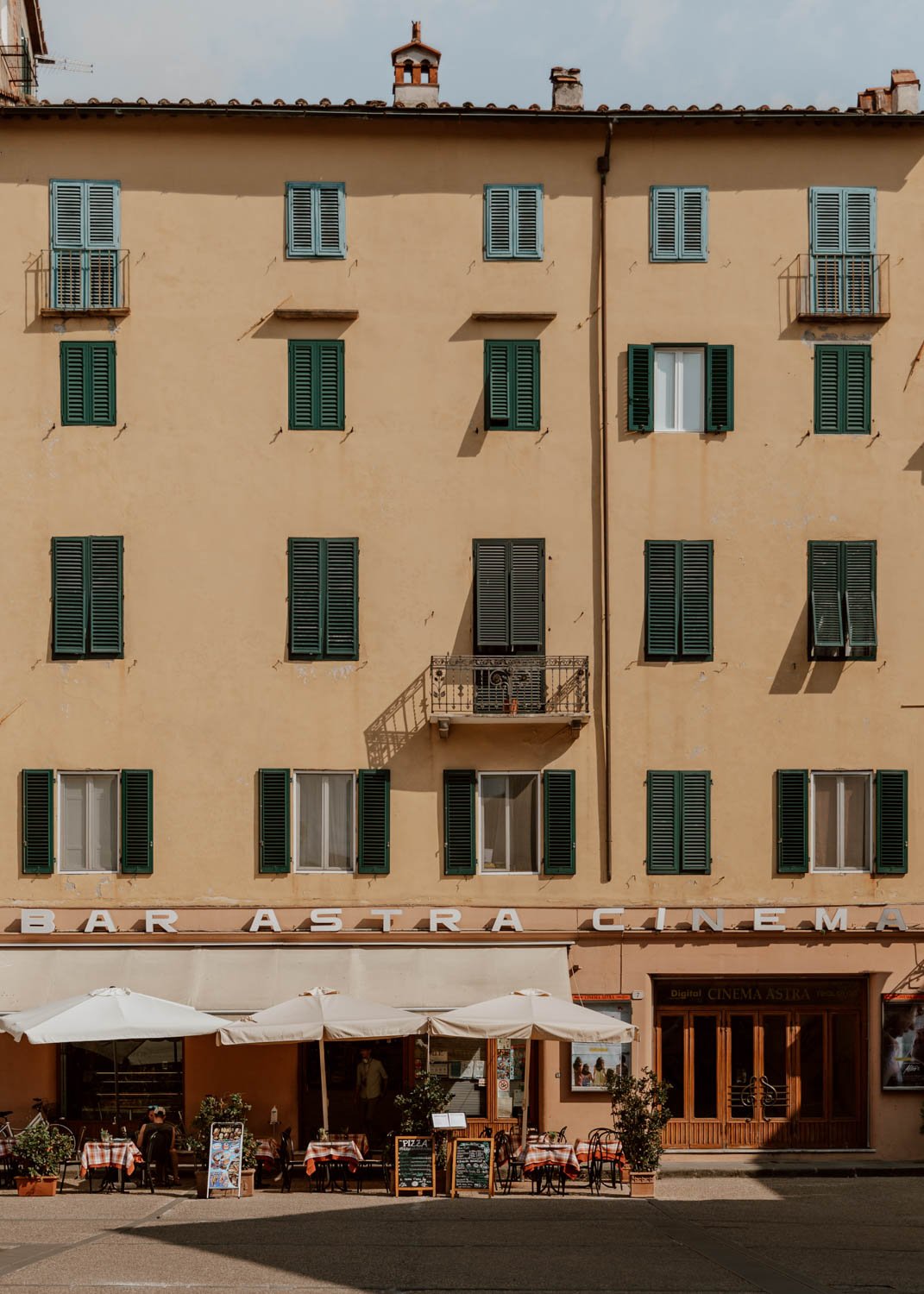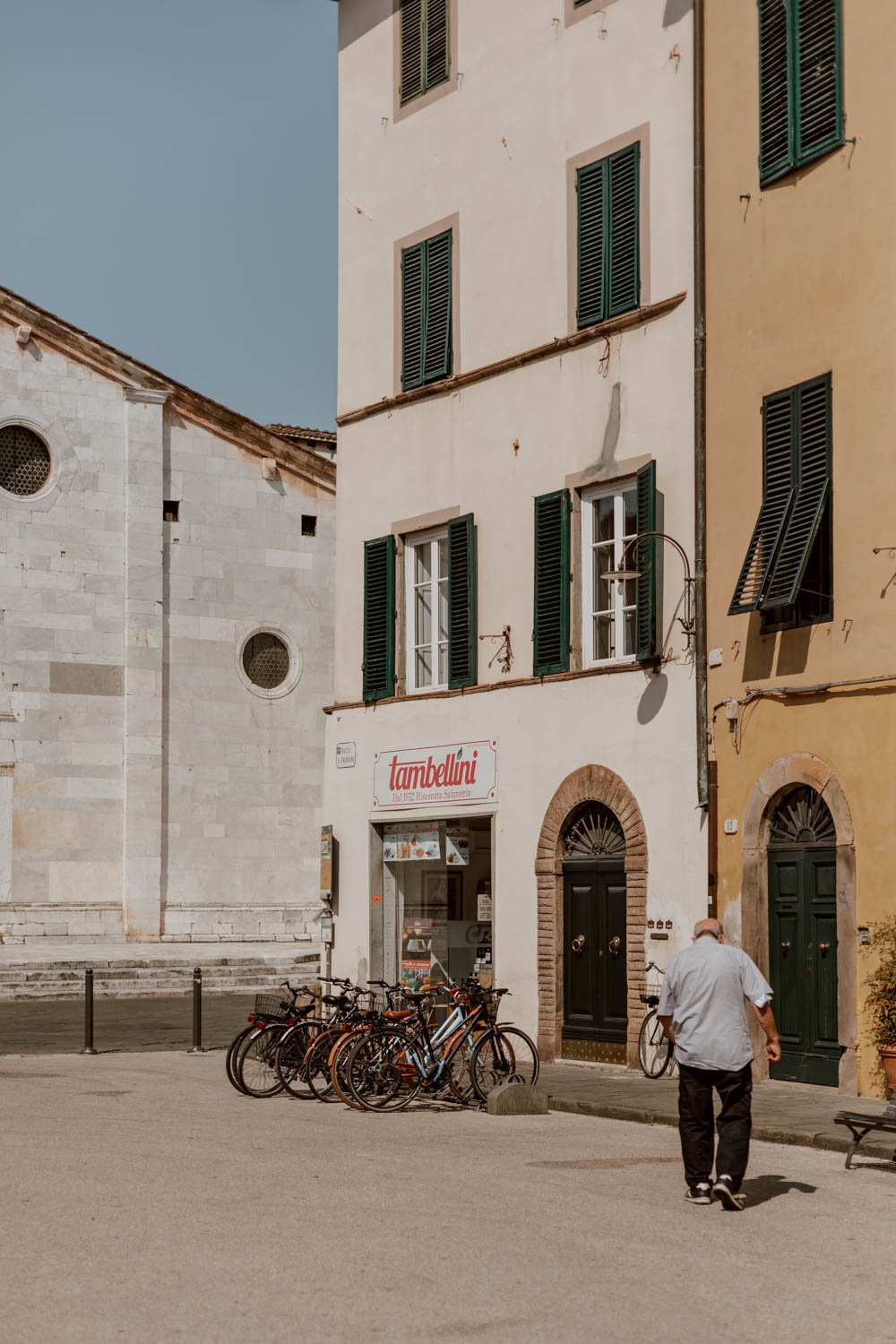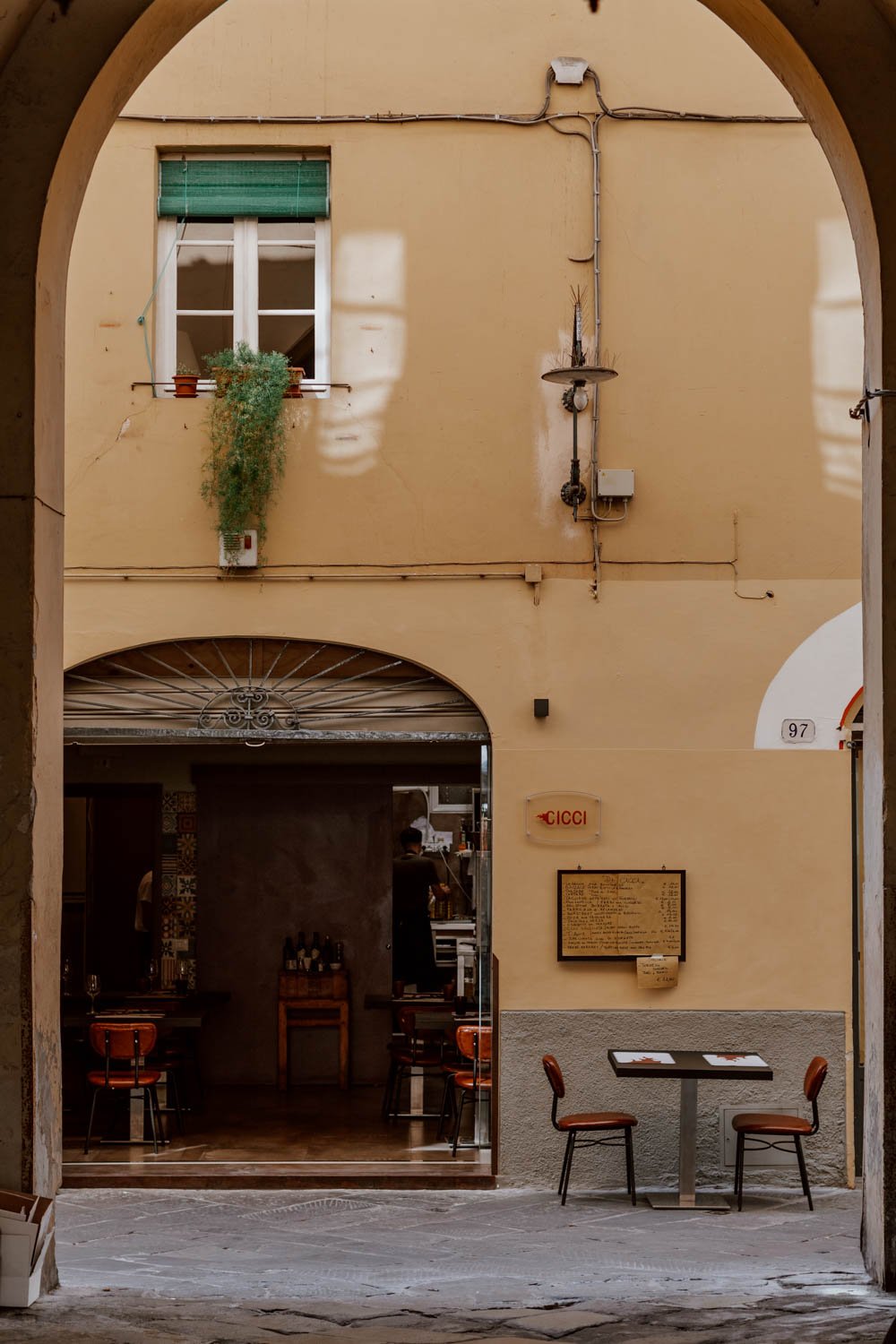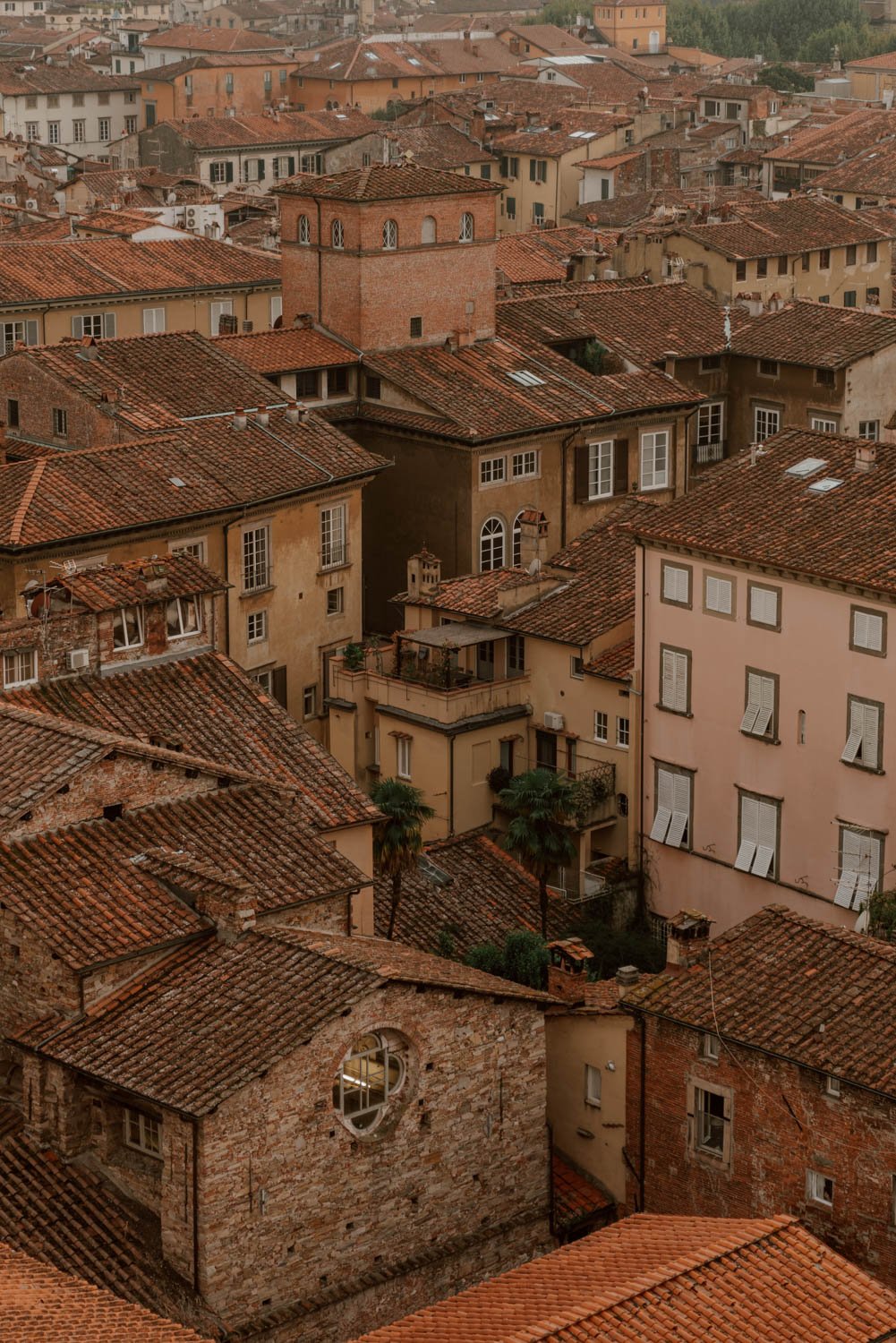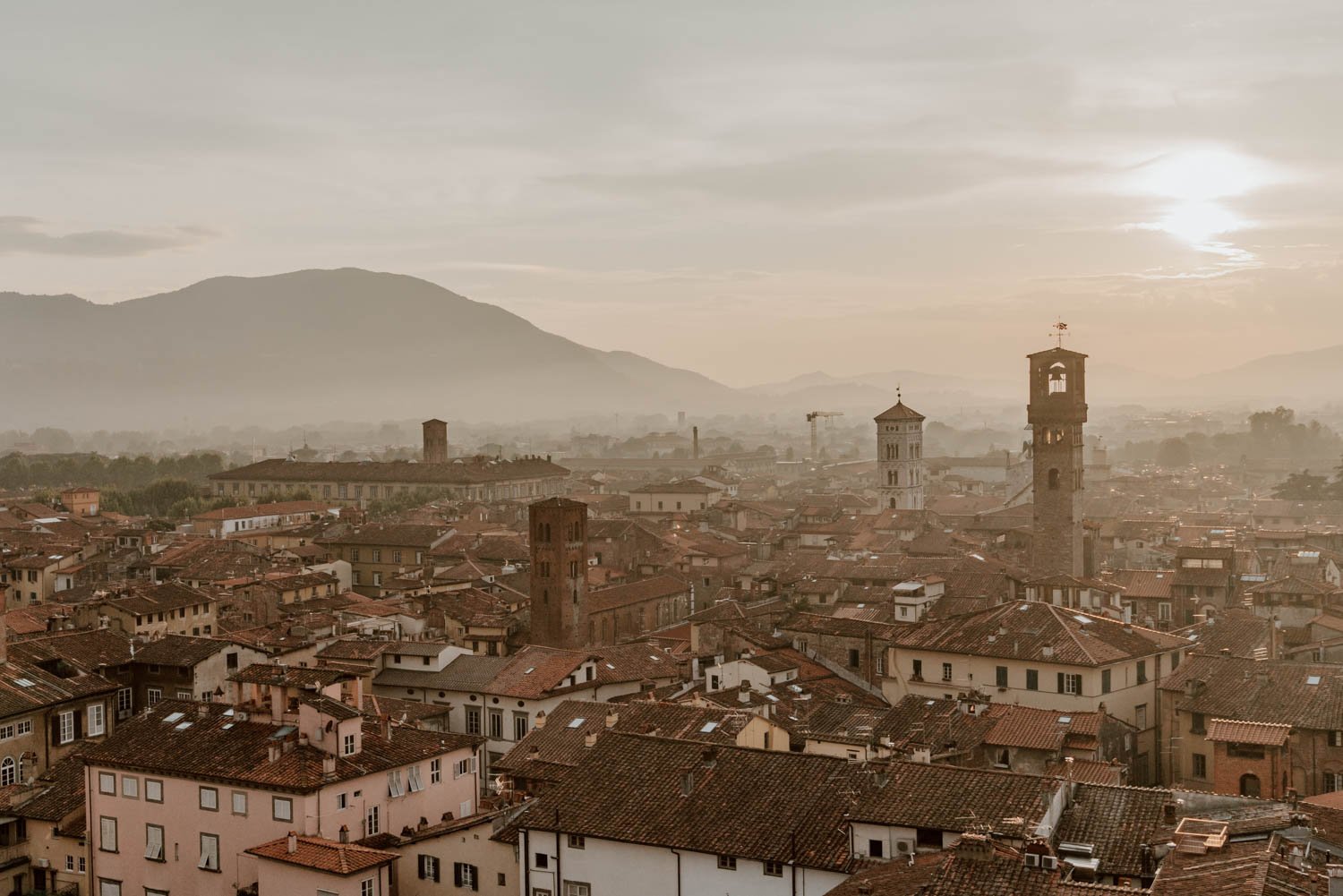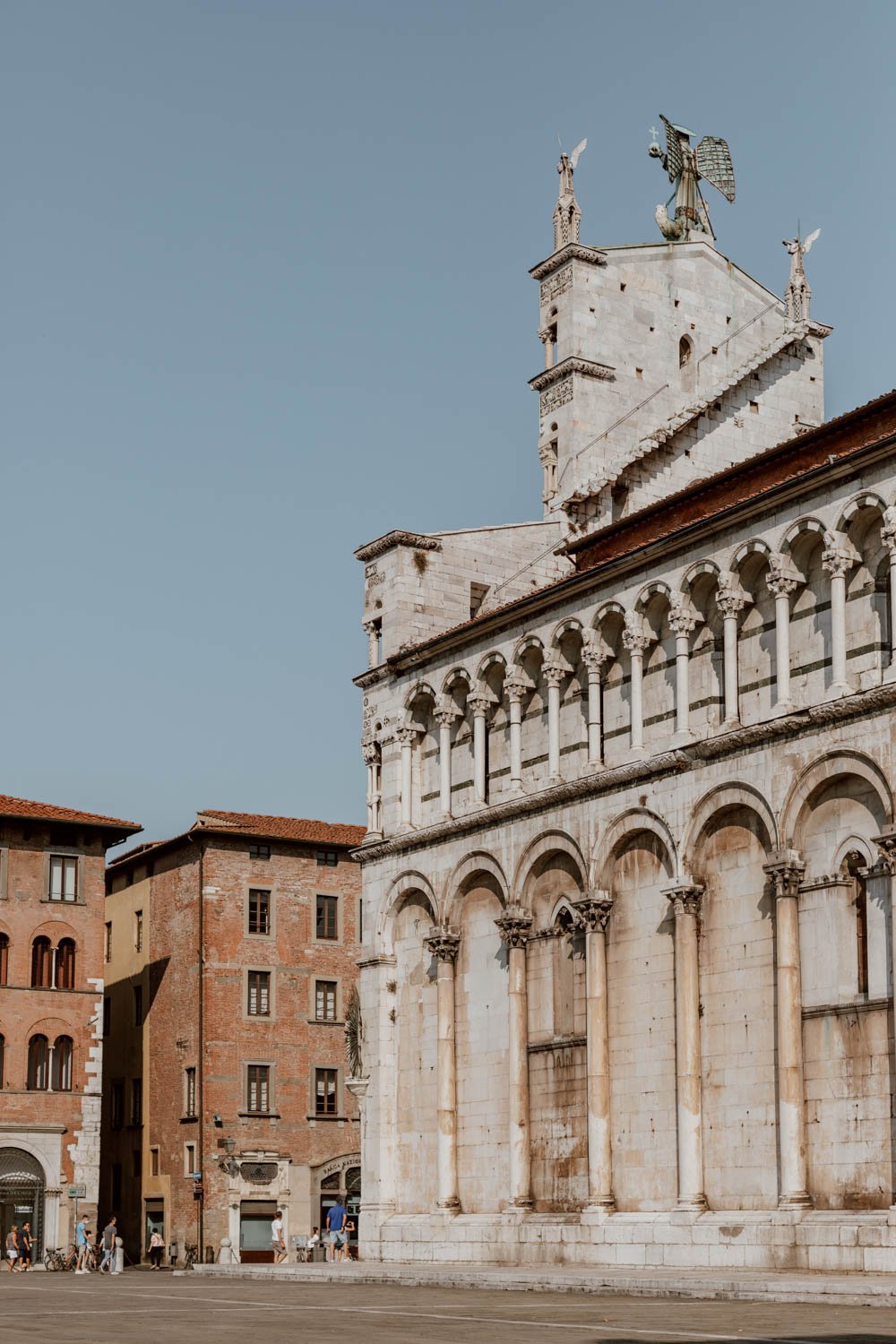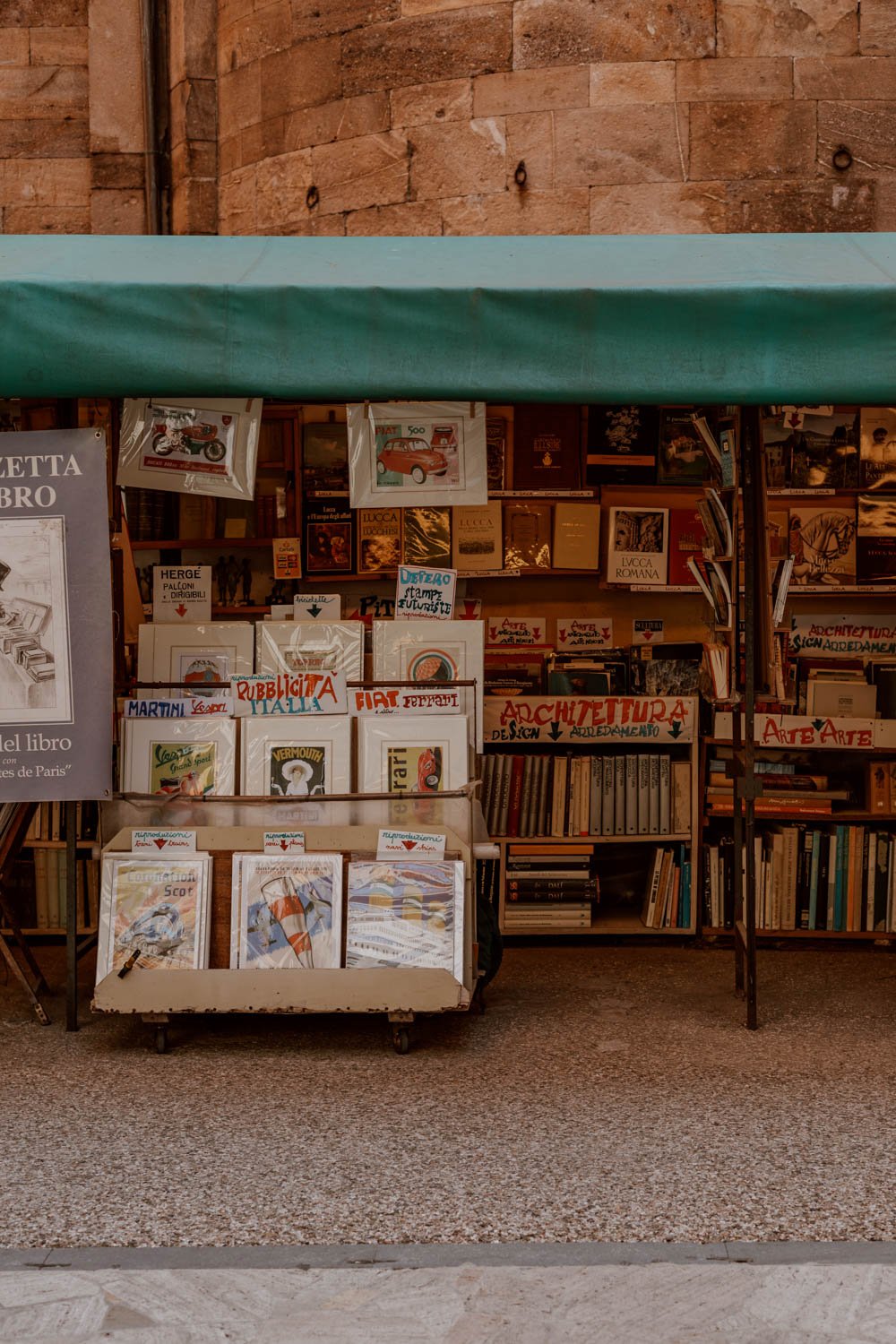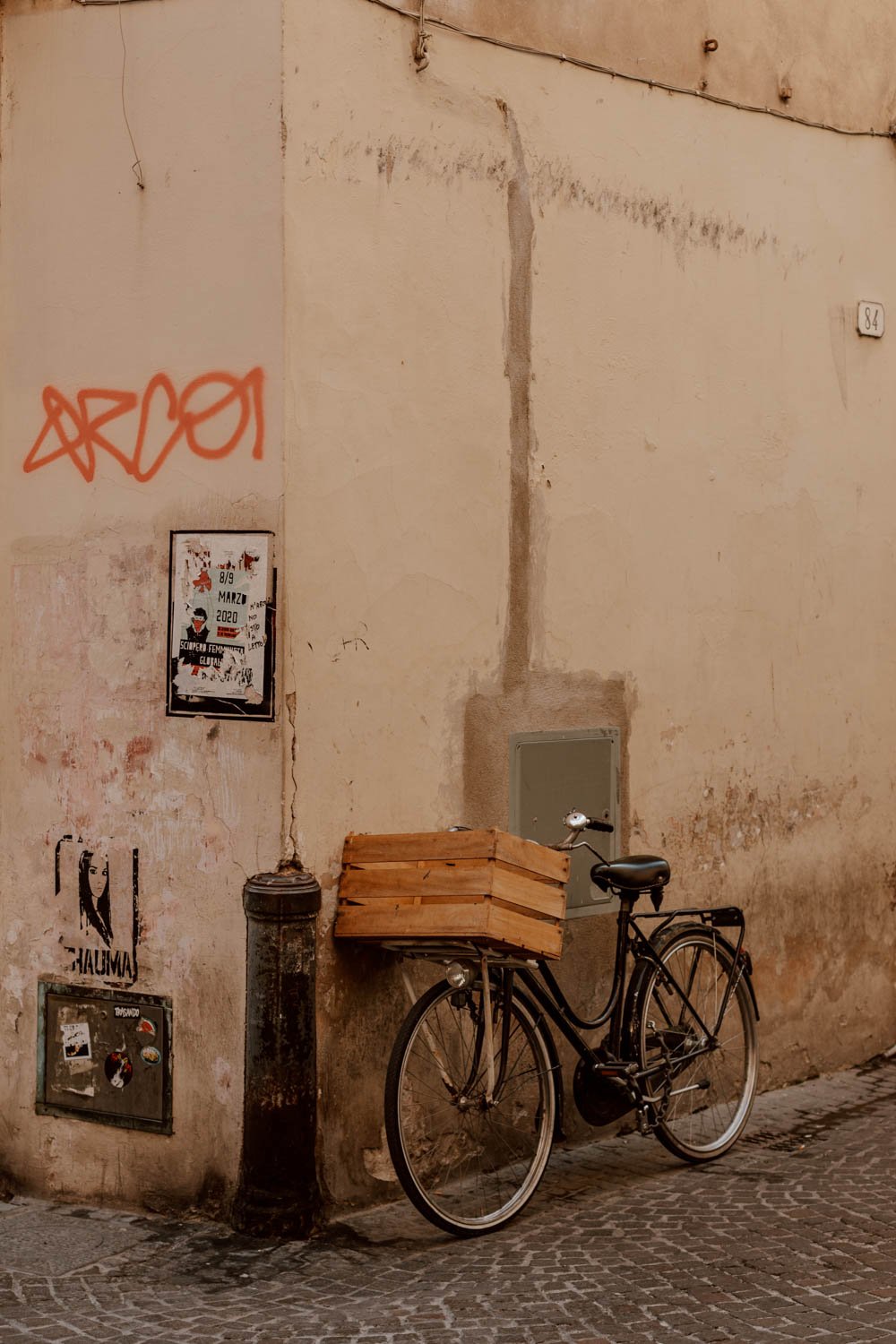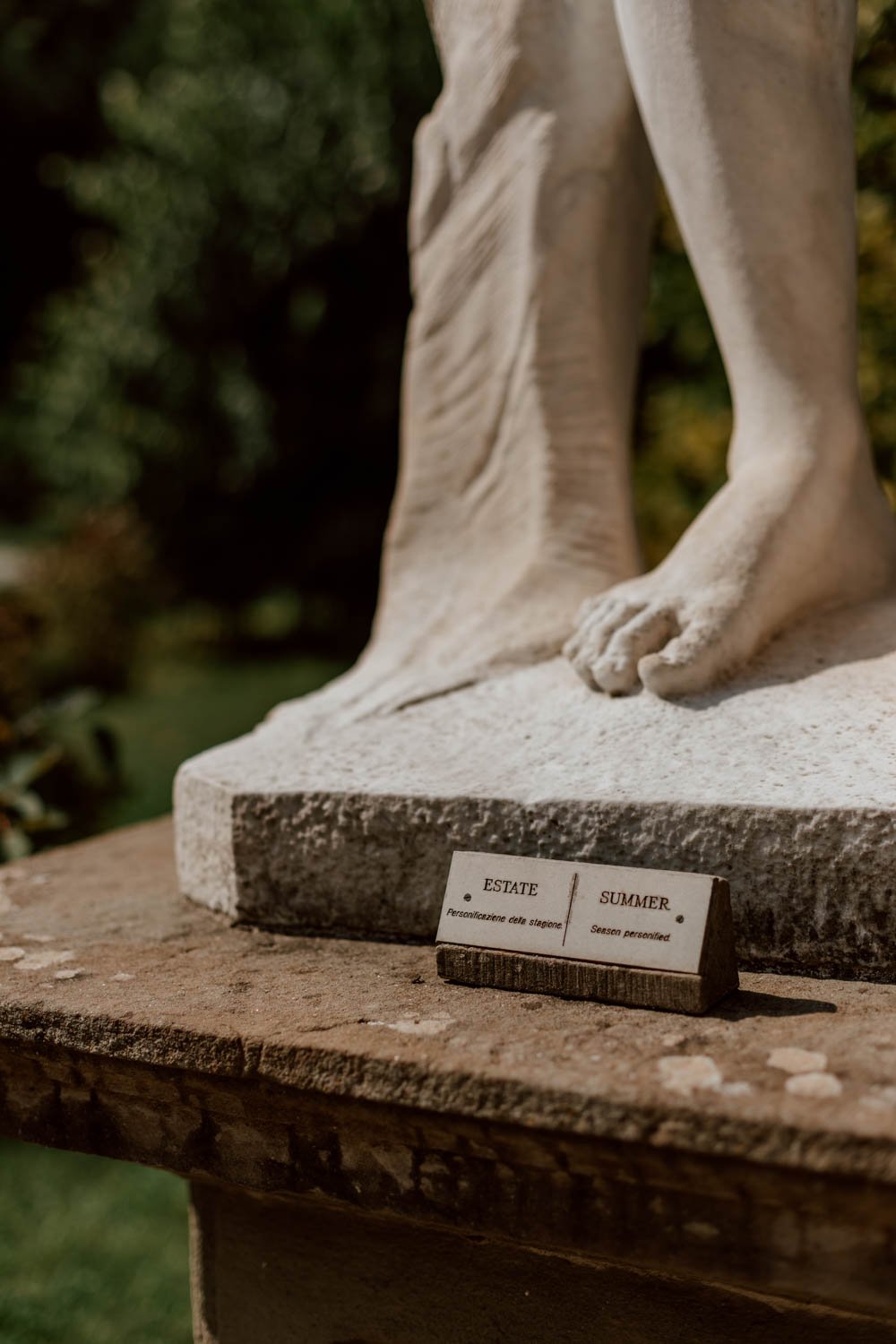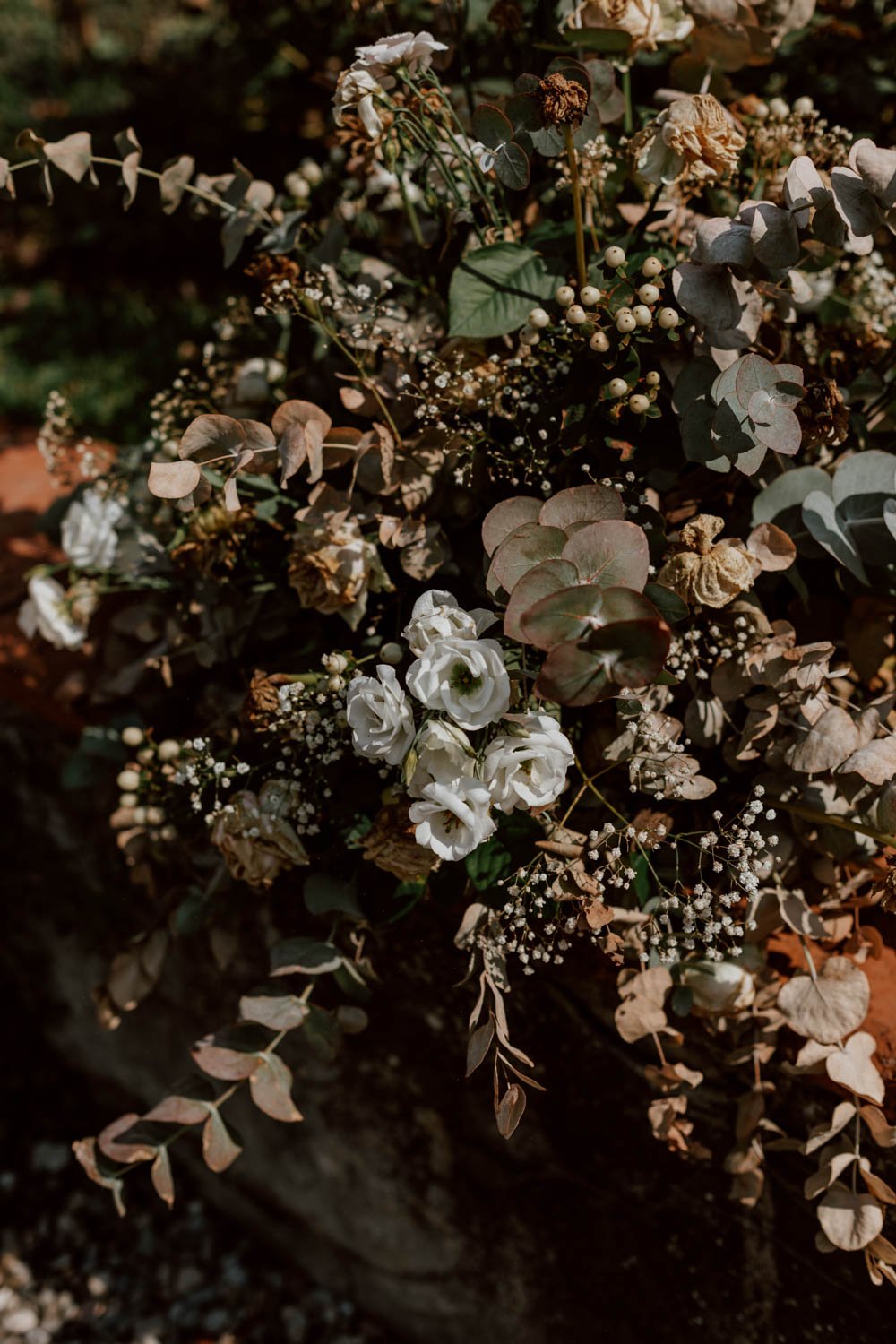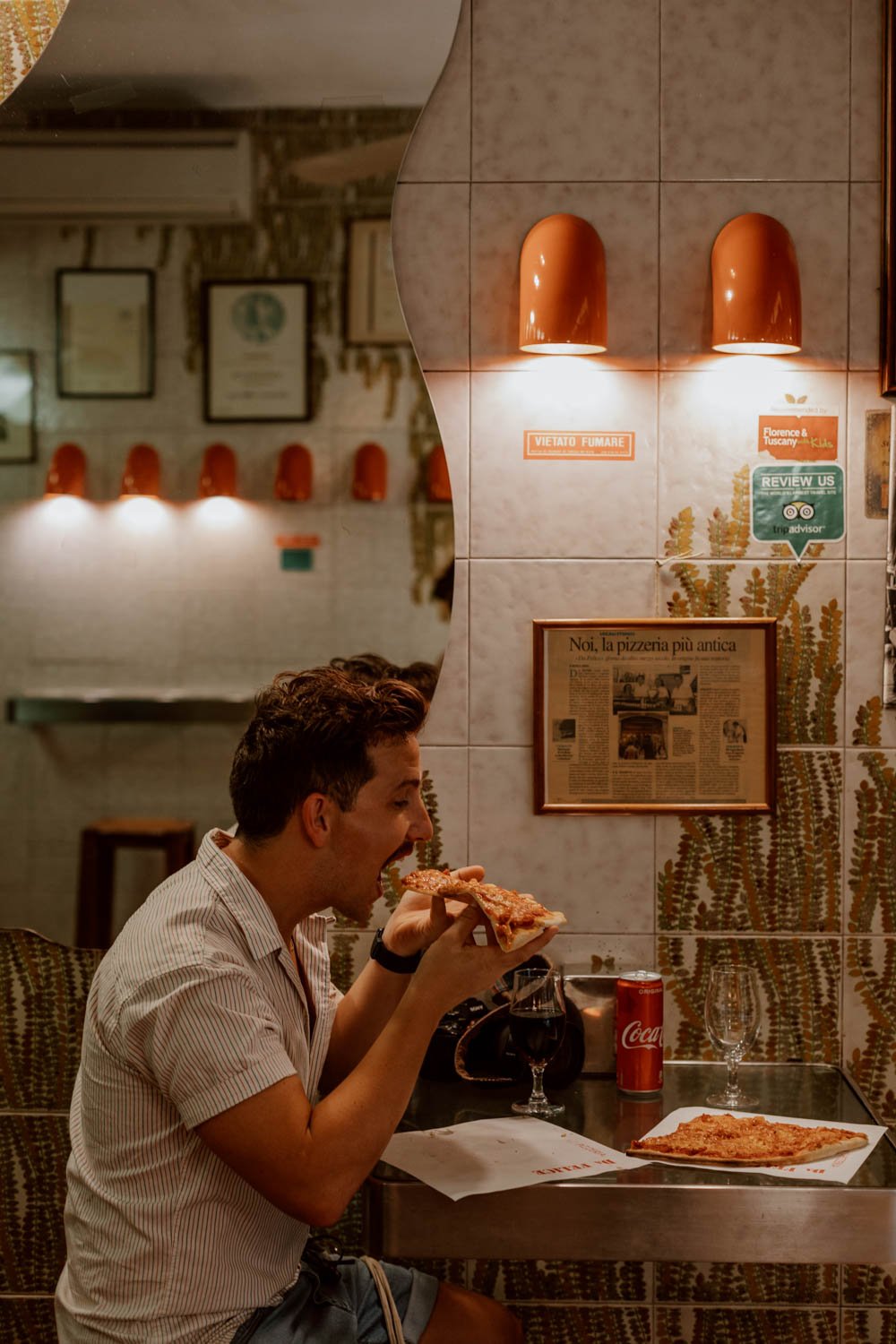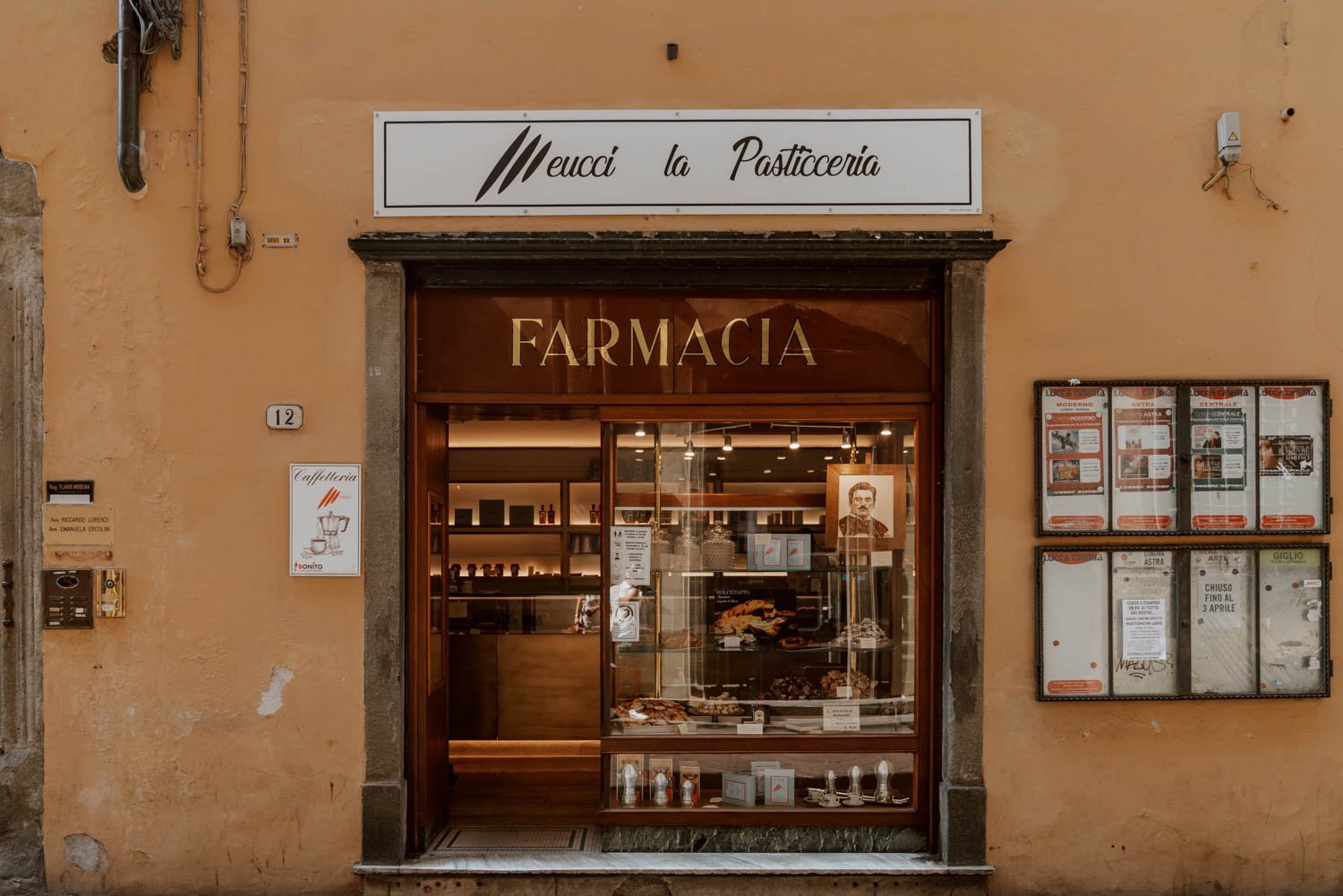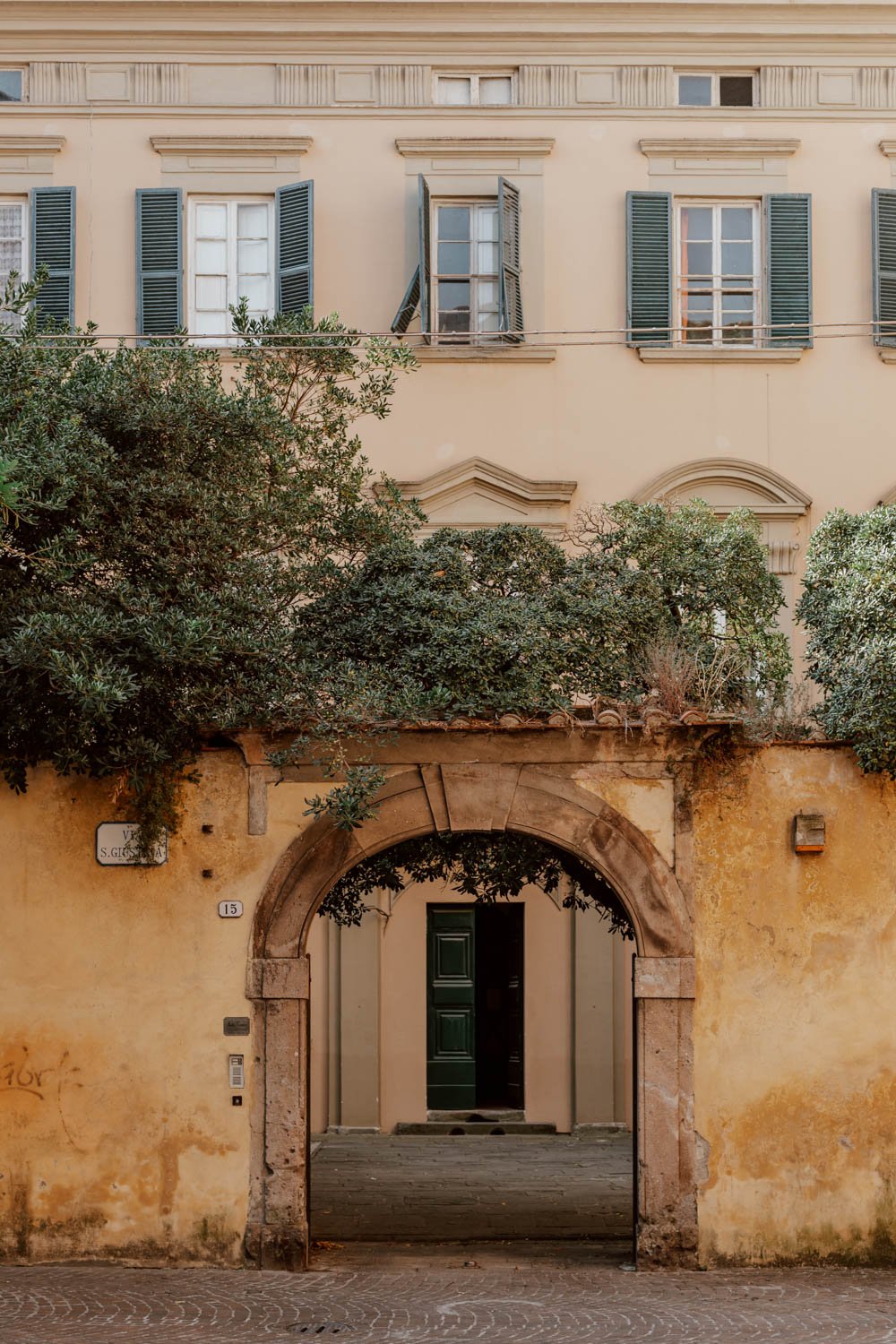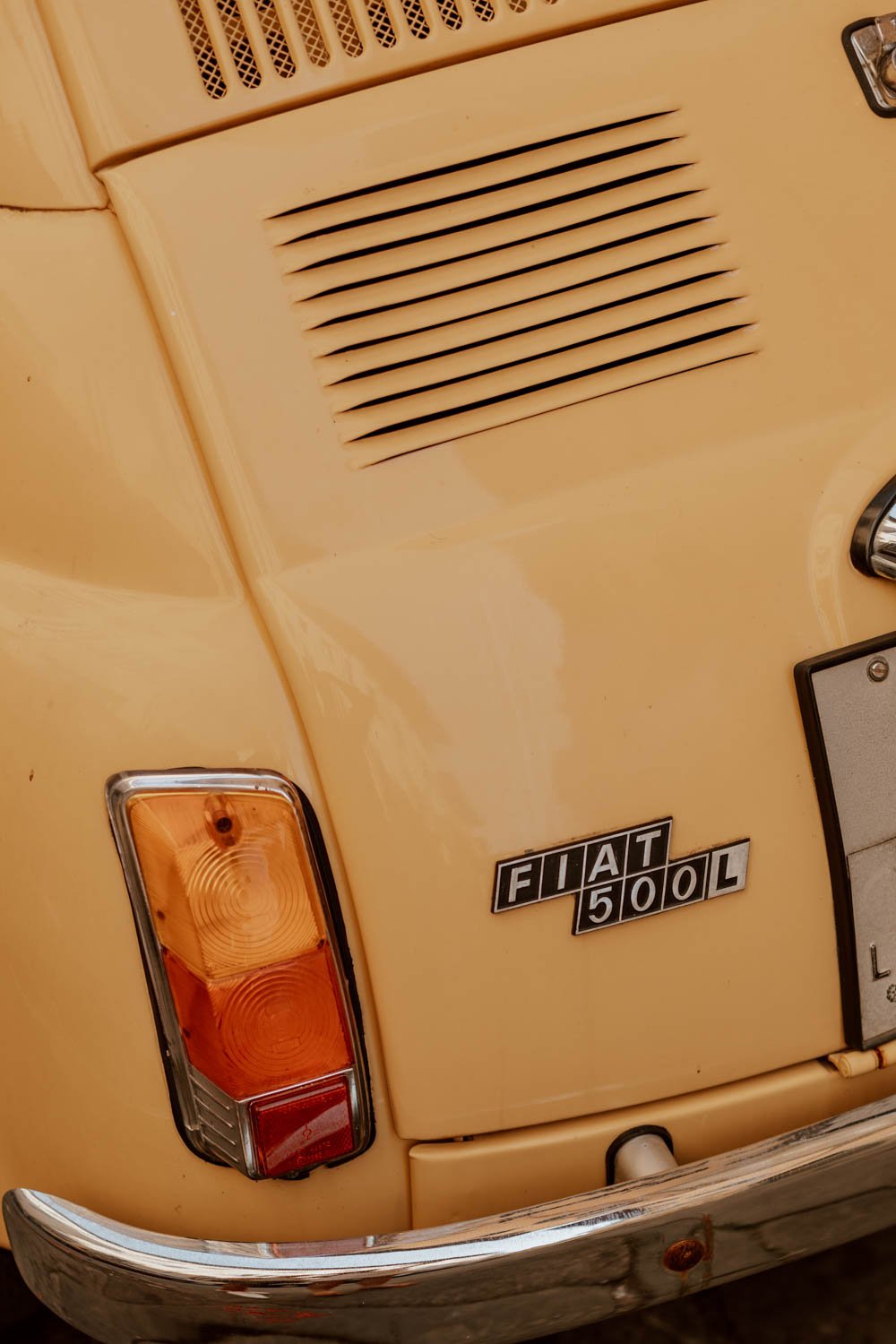Whether you’re planning to visit the walled city for a couple of days or use it as a base to see more of Tuscany, this guide has you covered with all the best things to do in Lucca, Italy - and our insider tips on where to eat and stay!
It’s the little moments which make a place memorable.
The early morning scent of sweet pastries carried through a narrow street of peeling paints, and into your attic apartment. Bells of church and bicycle ringing out to sound the alarm of a neighbourhood rising from its slumber. The operatic melodies of the music school - piercing arias and virtuoso piano performances of nimble fingers and soft throats - floating through windows cracked open to let the summer heat escape. The feel of a brown paper bag of warm focaccia in your hands, greasy fingers from pizza slice stops on tipsy cycle rides home, and the last linger of truffle on the tongue.
By twilight, the players of Puccini gathering, casting spells over silent crowds on the corner of the piazza where a disguised diamond twinkles.
Unlike its neighbours to the south and the north, little Lucca doesn't pull millions in each summer with famous photo opportunities, world-class museums, or a history filled with renowned Renaissance men.
But that doesn't really matter.
In this small walled city, you can instantly feel at ease. You can ride your bicycle along ancient walls, stop for a mid-morning espresso, amble along cobblestone streets toward nothing in particular, and bask in the cultured approach to life and seek out those small joys. Unhurried and less crowded than Florence and Pisa, Lucca requires much less of a regimented plan than the former and offers much more to enjoy than the latter.
As the surprising location for Europe’s biggest comic book convention and one of Italy’s best summer music festivals, it’s also got a lot more going on than one may assume.
Weave in all the signature experiences of an old northern Italian city - the medieval towers, the palazzos and piazzas, the temptation of local flavours, artisans, and romance - and you've got a pretty special place.
In our destination guide to Lucca, Italy, you'll find all the essential information + inspiration to plan your own visit to this beautiful walled city in Tuscany. Alongside our favourite things to do in Lucca, we've shared insider tips on where to stay, where to eat, and advice on transport connections from elsewhere in Italy.
Andiamo!
lucca essentials
// A compact historic city of 90,000
// Encircled by a four kilometre long 16th century wall
// The birthplace of Puccini
// A great option for 2-3 nights, or a base for Tuscany adventures
// Easily reached by train from Florence, Pisa, or Cinque Terre.
Our Favourite Things to Do in Lucca
Rent A Bicycle & Get Lost
We don't know why so many Lucchesi ride bicycles, but we sort of love it.
You'll see young and old, rich and poor, extrovert and introvert getting around the flat historic centre on two wheels, and it certainly adds to the laid-back vibe of a village masquerading as a city at times.
Lucca's reputation as a haven for cyclists spans Italy, and it's actually a popular choice for serious cyclists (including pros) to base themselves for training or bike holidays in Tuscany. However, within the essentially traffic-free old town centre it's not about carbon fibre and lycra, but commuters with dogs in front baskets, pizza boxes balanced on handle bars, and movie star women pedalling nonchalantly along the cobbles.
You can of course eschew the saddle and explore Lucca happily on two feet rather than two wheels, but we think it should be thought of as a way to enhance the experience of the going from piazza to piazza, pretty side street to pretty side street, and stopping of at many of our favourite things to do in Lucca.
Where to Rent A Bicycle in Lucca
It's easy to rent a bicycle in Lucca - you’ll find places all over the city offering noleggio - and you can pay by the hour, for the day, or a longer stretch. However, costs do vary quite widely between companies and the type of bicycle you choose (normal, hybrid, electric).
If here for a few days or longer, it's a really good idea to try and bag yourself an apartment or Airbnb which includes bicycles but if not, places to rent from include:
Tourist Center Lucca | Close to the train station (Google Maps) so a sensible pick-up point for day trippers. City bikes (€8 for 3 hours, €12 the day), hybrids (€12 for 3 hours, €18 the day), and electric bikes (€14 for 3 hours, €21 the day). It also offers luggage storage, but note that this is NOT the official tourist office.
Cicli RAI | Normal bikes are €4 per hour / € 20 the whole day, whilst a rickshaw is €12 (2 person) / €18 per hour (4 person). Find them at 66 Via San Nicolao (maps), open from 9am to 8pm.
Poli Antonio Biciclette | Their in-house manufactured bicycles are ridden all over Lucca by local, but they also rent them at €4 per hour or €16 for the day. Find their shop at 42 Piazza S.Maria (maps)
You can also rent online in advance here - or alternatively, consider taking this private guided bicycle tour of the city.
Note that 'for the day' doesn't mean a 24-hour period but rather a full day (usually until 6am-8pm, but this depends on the rental company); you can however rent for 24-hour periods too. If renting for multiple days, then enquire about discounts available. A photo ID or a deposit may be required. There are also a number of cycle rickshaws for 2-4 people; they’re popular with families or groups but we’re not fans of them.
As ever, just lock up your bicycle as a precaution when leaving unattended, and don’t leave them out overnight.
Walk the Walls of Lucca
Where Pisa has its tower, Rome its Colosseum, and Florence its Duomo, Lucca has its walls.
Certainly not as famous or eye-catching, but we know which we’d rather have in the city we live in.
As in England, many Italian towns and cities saw their walls removed, repurposed, or destroyed once their foundational purpose was no longer a pressing concern; Lucca however, like York, retained her wall.
Today, atop the fantastically preserved red-brick fortifications which encircle the historical centre, you’ll find old boys bantering on benches, lovers strolling arm-in-arm, children playing amongst centuries-old trees, dogs on their daily constitutional, and citizens running or exercising; think of it as a public park on an infinite loop.
The original intent of the ramparts was defensive, with the century-long construction beginning in 1545 to thwart expansionist neighbours; they’re therefore much younger than one may assume, given fortifications of this nature were most common in the medieval period. Redundant by the 19th century, at the behest of Napoleon’s sister, they were converted into the green space and walkway we can enjoy today (a radically progressive idea at the time).
There's a delicious irony in the fact that something built to keep people out now draws so many in.
The walls of Lucca are perfect for a pre-aperitivo passeggiata or a leisurely lap to get acquainted with the city, but we'd highly recommend taking your rented bicycle up there to peddle along it at a gentle pace for an hour or so.
There are views of church towers and gardens, homes and rooftops, and beyond the walls into 'New Lucca' and the Tuscan hills beyond. Those vibrant wide, green spaces you’ll see directly outside the walls of Lucca were once a moat!
The Esentials
There are various stairway and ramp access points dotted throughout, some steeper than others, but the most convenient to make a beeline for with a bicycle are: Via Veneto (maps); Rampa S Paulino (maps); Via Cimiterio (maps); Corso Garibaldi (maps) and Porta Santa Marina (maps).
If cycling/walking the walls in the early evening, exit on Via Veneto and you’ll find some lively cafes and bars for an aperitivo (Caffe’ Monica gave a decent Aperol Spritz with a stacked chopping board of food).
On your explorations around Lucca, you’ll also pass through several of the marvellously intact ‘Porta’ within the walls: Sant'Anna, Santa Maria, San Pietro, San Donato, and Elisa. These were the guarded entry points and thoroughfares, and if you go to Elisa you still a real sense of how these would have operated before bicycles, cars, and pedestrians started to use them.
If you’re short on time, this highly-rated 2-hour walking tour may be a good idea to get better acquainted with Lucca.
Eat at Osteria da Pasquale
This place was so highly recommended to us by a follower that it only took a quick glance at its menu for us make a reservation for the upcoming weekend.
Eating at Osteria Pasquale summed up the laid-back charms of Lucca: hidden away, welcoming, reasonably priced, generous, unfussy yet underpinned by absolute quality.
We don't make a point of eating out at terribly fancy or highly-rated restaurants too often when we travel, so when we do we really expect it to be an occasion to savour; this wee gem went beyond our expectations.
Pasquale, the charismatic English-speaking owner, is hands-on and dances his way around the tables to speak with diners (but not in an annoying, invasive way). A sommelier by trade, his expertise lies in giving you a clear recommendation on what to pair with your dishes and to your preferences from his extensive - but very fairly priced - cellar. If you're the type who simply goes for what is either 1) cheapest or 2) has a funny name when looking at a long wine list, then you should rejoice at this fact! His recommendations for each of our courses were bang on the money for us.
The brief, curated menu focuses on season and regional ingredients. Meat-eaters will find hearty Tuscan fare, but it always includes one or two vegetarian dishes too as well as some seafood.
You can find Osteria da Pasquale on 8 Via del Moro (maps). The are open Wed - Mon, 7.30 pm to 10.30 pm. Reservations are essential; book via their website, or email sassicaia@hotmail.com
Piazza dell'Anfiteatro
Whilst Roman amphitheatres remain standing in several Italian cities, such as Verona and Rome, Lucca’s venue for entertainment and spectacle became something altogether quite different.
Foritified about five centuries after its construction in 1 AD, citizens began to build a clustered collection of homes and shops within and on the remaining shell of the old oval arena during the Middle Ages. Other parts of the structure were taken and used elsewhere to build the city.
Lucca had lost its ampitheatre.
Step forward Lorenzo Nottolini
A man synonymous with many of the architectural and urban changes which transformed the city in the 1800s, under his direction the buildings within the space were demolished others were preserved or built along the lines of the arena. This restored the sense of the original elliptical structure’s space and aesthetic.
Lucca regained a centrepiece - a piazza like no other Italy.
Piazza dell'Anfiteatro (maps) is not just an architectural curiosity though; it’s also the busiest square in Lucca. Within its arcaded-walls, there are lots of bustling restaurants and cafes (some a little tourist-centric, others not) to enjoy a drink or lunch in the open-air. During the day, there are artisanal wares or produce stalls set up, whilst at night it’s got a pleasant social atmosphere to go with the unique setting. In summer, there are sometimes concerts and shows too.
In the outer ring, the narrow elliptical via dell'Anfiteatro adds to the senes of following the outline of a Roman Amphitheatre, and it has more restaurants, bars, and cafes to choose from - do a loop or two in the day and in the evening, and pair it with strolls from Porta dei Borghi along Via Fillungo, the main street in Roman times and still a hive of activity today.
We didn’t eat on via dell'Anfiteatro, but the interior design at Trattoria Da Ubaldo is…eye-catching…whilst Osteria Baralla serves up traditional Tuscan fare, and we could have filled our suitcases several times over at Uashmama (maps). A restaurant by the name of Cicci is the one that really caught our eye though! With a menu that is perhaps a tad limiting to vegetarians, the vibe looked good and they also do a good value lunch menu!
Good To Know // Piazza dell'Anfiteatro, sometimes referred to as Piazza Del Mercado, has four entry gateways to choose from. If you want to get a true sense of the shape and outline of Piazza dell'Anfiteatro, have a look in the aerial street view in Google Maps here.
Note that the restaurants inside it weren't actually all that dear, but you may pay a little more than elsewhere for a coffee or a lunch. Truthfully, we actually preferred the people-watching and setting at Bar Il Quadrifoglio on Piazza San Frediano, just outside.
If you’d like to learn more about the history of Lucca as you explore the city, check out this highly-rated walking tour.
Climb Torre Guigini
There are no shortage of medieval or Renaissance towers across Italy, and the most famous one is actually a short day trip from Lucca (that's the Leaning Tower of Pisa by the way...)
The red brick Torre Guigini is however, as far as we're aware, the only one with trees sprouting out the top.
At 44.25 metres tall and still one of the tallest structures in the skyline, it was built as a visual representation of the Guigini family's wealth and power in the 1300s (long story short, rich Italian families loved to build competing towers in their home cities). Records from the 15th century describe a curious tower with trees atop it, so they are thought to have been there for most of the structure's life as a sort of rooftop garden, as well as adding a distinctive flourish to set it apart from the 250 or so other towers populating Lucca at the time (sadly, only nine remain).
I'm still pondering where exactly the roots go though....
Although the Holm oak trees at the top draw much of the interest, it's the sumptuous views from under their branches which makes the walk up 200 or so stairs worth the effort. Whilst walking around the city at street level, one really doesn't appreciate that Lucca is protected on all sides by the rolling Tuscan hills which mask the sea, the cities, and mountain ranges beyond.
It’s a privileged position to call home.
The panoramic vista will be marvellous at any time of day, but we timed our ascent of the 230 steps for the golden hour just before sunset, where the skies around Lucca burned orange - unforgettable!
The Essentials
Tickets | €5 adult / €4 reduced, or part of the €12 combined ticket with another tower and Botanical Garden (more on those later). Visits are for 45-minutes and accompanied by a guide.
Where | In the old town centre, the entrance door is at 45 Via Sant'Andrea (maps)
When | The Guigini tower is open from 9.30 am, with variable closing times depending on the time of year. In summer (June-September), it closes at 8pm (last entry at 7.15 pm), but it’s 6.30 pm (April-May), 5.30 pm (March & October), and 4.30 pm (November-February).
Accessibility | In contrast with the Duomo in Florence or the Leaning Tower of Pisa, or similar red-brick towers in Bologna, the modern steel stairs inside Torre Guigini are much wider and more easily accessible for the general public. There’s no lift to the top though.
A Drink in Piazza San Michele
Staying in the quiet backstreets a few minutes from Piazza San Michele, we naturally gravitated toward this square quite a bit during our week in Lucca.
Dominated by the intricate details of the 12th century San Michele in Foro church, we’d linger for people watching, breakfasts of capuccino and fresh brioche, glasses of chilled vermentino, or picking up pizza slices for the road or cycle home. Most evenings, a busker played Puccini on his cello, stopping everyone in their tracks.
During the day, make sure to spend enough time gawping at the astounding marble facade of San Michele, which takes centre stage in the square. Built on the site of the old Roman forum, the church is one of Lucca’s principal architectural and spiritual landmarks, and a standalone work of art.
Legend says that an enormous diamond is set in the angel’s statue, only possible to see glimmering from a particular point in the piazza under cover of darkness (we tried and failed).
Piazza San Michele (maps) comes alive with chattering, socialising locals enjoying their passeggiata or meeting on the edge of the church stairs for dates and drinks, as well as becoming a bit of a late-night hangout spot for students in the smaller hours. This atmosphere was the reason we spent more of our evenings here than elsewhere, and we never felt we were missing out by staying put instead of going to the more famous ampitheatre piazza a few minutes walk away.
A few of our favourite haunts were Turandot and Marsili Costantino for €5 vermentino, and Pizzeria Pellegrini for a quick snack slice, whilst there are also a couple of unpretentious cocktail spots in and around here like ReWine and Lebowskis.
Good to know // Chiesa di San Michele in Foro is free to enter and open to visitors from 7.30 am - 12 pm, then 3 - 5.30 pm. Find it here on Google Maps - please dress and act appropriately as this is an active place of worship.
The Comic Book & Music Festivals
Hands up if you knew the second-largest comic book festival in the world takes place here?
Yep, we wouldn't have guessed Lucca either.
Walking around in summer, beyond a few specialist stores, you don't really get many hints that this is a comic book city. However, come October, it’s taken over by cosplayers, gamers, and comic book enthusiasts for the Lucca Comics & Games convention. Second only to Comiket in Japan, it attracts nearly 300,000 attendees over the course of the four days!
So, why Lucca?
There are no real ties to the city with any famous character, publisher, or publication, but the association began in 1966 with a group sharing their passion. It grew over the decades, but had a few bumps in the road, suffering from competition with a similar convention in Rome during the 90s. The two ultimately merged though, with Lucca being chosen as the permanent home.
The city is also a standout location in the Italian music calendar. Since its creation in 1998, the biggest names in music - Dylan, The Rolling Stones, James Brown - as well as emerging stars have played at The Lucca Summer Music Festival. It's a series of concerts across June and July, rather than a standalone festival, but it's often the only date that major acts may play in the country in the year.
Gigs are often held outside the city walls, but can also take place in the large open-air Piazza Napoleone, which would be a pretty cool venue.
The Essentials
The Lucca Comics & Games convention takes place at the end of October - find out more on the official website here. If you plan on going, then we highly recommend you book your accommodation as soon as possible (see our 'Where To Stay' section below for recommendations).
If you're into comics, then you should definitely check out our travel guide to Angoulême - the unrivalled comic book capital of Europe!
The Lucca Summer Music Festival won't have the same impact on your visit as the Comics convention, but it's worth bearing in mind as it may affect accommodation prices / availability and result in Lucca being much busier than you expect! However, tacking on a concert to your visit would also be a wonderful thing to do in Lucca.
Find out more or buy tickets here.
The Gardens of Palazzo Pfanner
This refined Palazzo, built in the late 1600s, is not a place one would immediately associate with beer. Yet, it passed between several families before an Austrian brewer named Felix Pfanner arrived in Lucca to answer the Duke of Lucca’s call for the town to have ‘a German brewer’. Setting up shop in the garden and cellars here, he was eventually successful enough to buy the whole palace!
Dotted with statues amongst the manicured greenery, and with the walls and towers as a backdrop, the baroque courtyard and gardens are very much worth a stop, offering a pretty and peaceful setting to find some shade or escape crowded summer streets. Scenes from Portrait of a Lady with Nicola Kidman were filmed there.
Overall though, we think the entry price is on the high side, with much of the Palazzo - still owned by the Pfanner family - shut to the public and the gardens being quite small. After an expensive week in Florence, budget dictated that we could choose only the gardens or the palace to enter; after having read many reviews from others, our choice to visit just the gardens was validated.
The Essentials
Tickets | It’s €6.50 to visit both the gardens and the palazzo, or €4.50 individually.
Where | The entrance for both is here.
When | The gardens are open between Aril and November only, 10 am to 6 pm each day.
Insider Tip // Anyone with a passion for typography and artisanal craft MUST stop at Antica Tipografia Biagini . Owned Roberto and Antonio, two typographers, they continue to work and preserve the art of manual composition and printing. It’s small and intimate with antique equipment, but places like these deserve to be support and loved, and you could get yourself a very unique souvenir of your Italian travels - find it here.
Discover The Life & Music of Puccini
Alternatively, decide to put your money toward a visit the small Puccini House Museum. Lucca’s favourite son, the prolific composer was born here in 1858 and the property has been restored into a celebration of his musical genius, his life and his famous opera works. The museum itself won’t blow you away, but may start a lifelong affair with his music.
Adults tickets are however on the pricier side at €9, so we won’t judge if you eschew it. Find it at number 8 Corte San Lorenzo (maps).
There are also lots of Puccini concerts in Lucca during summer, including these recitals in an old church each Thursday to Sunday.
You can buy a priority ticket here.
Tip | During your travels in northern Italy, we recommend you eschew podcasts or your carefully-curated Spotify playlists for a bit and immerse yourself in the works of Puccini for a bit. Start with Turnadot (from which ‘Nessun Dorma’ comes), then go to Tosca and La bohème.
If you want to know the best city and venue to experience opera in Italy by the way, read this post.
Carb Load Corner
It’s Italy. You’re hungry. Go indulge.
There are different rules to the amount of carbohydrates one is permitted to enjoy each day as soon as you enter the country, and it’s a cultural imperative that you take advantage of this.
Wine intake is also subject to the same rule.
To get you on your way, head to these three places all within a minute of each other for a snack, lunch, or pre-dinner dinner:
Forno a vapore Amedeo Giusti | Our Airbnb host told us this pretty, traditional bakery served up the best focaccia in Lucca. We turned up and ordered bags of everything savoury (the Italian sweet tooth is too sweet for us). Not everything in the paper bags hit the high notes, but some of it was spectacular. It’s very cheap, but note that prices are listed per kilo - there’s often a queue too, so try not to dally too much. Find it here.
Pizzeria da Felice | Just round the corner, and still family-run, the city’s oldest pizzeria serves everything by the slice. It’s unfussy and casual, so simply turn up, pick, and eat quickly at one of the tables or on the stools outside. As with the bakery, it’s priced on weight of the slice. They also have a few other specialties, like a castagnaccio, the a chestnut-flour pancake stuffed with sweet ricotta. Find it on 12 Via Buia (maps) from 12–2:30 pm / 4–8:30 pm (9 pm on Saturdays), closed Sundays.
For a more formal, sit-down pizza in the evening, a follower recommended Gli Orti di Via Elisa (maps) to us but we weren’t able to try.
Antica Bottega di Prospero | A lovely deli and wine shop near the pizzeria and the bakery where you can get cheese or meat places, or buy local honeys, oils, sauces etc.
A few other places we liked eating and drinking at, or were recommended, and you should add to your personal list of things to do in Lucca, are:
Enoteca Vanni | Our little gem. From the outside, it may look like just a charming but small wine shop with a few tables outside. However, its hidden cellar is something else! This is the place to come if you would like to drink from a excellent range of local and non-local wines at affordable prices, in an unfussy laid-back atmosphere. It’s also the best spot if you’d like to buy a bottle or two to take back to your apartment, but they do also ship internationally if you want to take a selection back home. Find it here; hours are short though, from 10 am–1 pm then 4–9 pm (closed Sundays).
Da Franceso | We popped in here for a quick and easy lunch and enjoyed a simple, cheap pasta plus carafe of wine. Ideal for those on a budget.
Antica Drogheria | This locals’ restaurant would be easy to walk by, but don’t do that if you want some excellent truffle pasta - find it here.
If looking for a good gelato, head for a cone or cup at Bottega del Gelato on Via Santa Croce (maps).
Trattoria da Giulio | We didn’t eat here but passed several times during the week when the traditional restaurant, slightly hidden away, serves its hearty Tuscan dishes in a lovely outdoor setting by the walls - find it here.
Aperitivo Tour | If you’d like find out a few more local spots to drink whilst tasting local produce, check out this Aperitivo Evening Food & Wine Tour.
Good To Know // Known as the The City Of A Hundred Churches, a few more to add to your wanderings in Lucca are the gilded Basilica di San Frediano, Cattedrale San Martino, and beautiful Chiesa dei Santi Giovanni e Reparata, which showcases several layers of civilisations and has a relatively interesting crypt.
Climb The Clock Tower
We’re of the opinion that the best view of Lucca is from Torre Guinigi (but that may because we decided that we only really needed to see one…)
However, not everyone agrees with that.
Of the nine medieval towers that remain standing, it’s the Torre dell’Ore (maps) which gives it a run for its money.
A clocktower has existed here on Via Fillungo since 1390 (crazy, right?), but the structure and the mechanism have undergone various works or renovations in the centuries since.
It’s a short, steep climb up 207 wooden steps to the top of the highest tower in the city, and some people actually prefer it because you can see Torre Guinigi and its trees from up here, as well as the terracotta rooftops. Its narrow, wooden staircase and the ringing bells at the top offer a more memorable climb (prepare yourself for those by the way!).
Climb one or climb both - just don’t leave Lucca having climbed neither!
The Essentials
Tickets | It’s €5 adult /€4 reduced entry, but if you wish to climb both Lucca towers, consider purchasing the €12/ €9 combined ticket. It includes entry to Torre Guinigi, Torre dell’Ore, as well as the Botanical Gardens (Orto Botanico).
Whichever option you go for, we recommend purchasing your ticket (standalone or combination) online in advance on line due to the ongoing visitor restriction and requirement to book specific time slots. The process can be a little convoluted, but this is the official website to buy them.
Alternatively, you have to buy them in person at the Torre Guinigi as the Torre dell’Ore does not sell directly.
If choosing between the two, note that Guinigi offers a modern, wider, easier climb up to the top.
Where | Find it here (maps)
When | The tower is open from 9.30 am, with variable closing times depending on the time of year. In summer (1st June-20th September), it closes at 7.30 pm. From 21st March-31st May and 21st-31st September it closes at 6.30pm and between 1st October and 4th November it closes at 4 pm.
The tower is closed to visitors from 5th November through to 20th March.
If budget is no limit, or you’re looking to surprise someone during your trip, then take a look at this hot-air balloon flight over the Tuscan hills which sets off from Lucca.
Where To Stay In Lucca
Lucca is a popular day trip destination, but we think the little city deserves a couple of nights to explore and experience slowly.
For those of you spending time in northern Italy, it’s also good to know that it is less expensive than other popular tourism hubs in the vicinity, and offers a first-timer or veteran of travelling in the country the chance to have a slightly more grounded, authentic experience. If you’re looking to do a language school, for example, this would be an ideal setting.
Due to this, it’s worth considering Lucca as one of your bases during your time in in and around Tuscany. From here, you can easily take the train to Pisa on a day trip, or travel onward by car or public transport to Cinque Terre, Florence, or into the Tuscan hills.
For our week in Lucca, we stayed at two different Airbnbs (one very good, one not very good), and in a city with so much history we 100% recommend staying within the walls and in a hotel or apartment whose own walls tell a story. We’ve shared our recommendations for all travel styles and budgets below - if you’re travelling in July-September, or arriving for the Comic Book festival in October, make sure to book early to get something good!
Note that unless otherwise stated, all accommodations are within Lucca’s city walls and any prices are based on a June occupancy.
Hotels & Guesthouses
Palazzo Rocchi B&B | A luxurious 4* guest house in the heart of Lucca's historic centre, set within an old Baroque palazzo. Expect extravagant room flourishes alongside grand furniture and decoration - plus, according to reviews, excellent and attentive staff. Find out more here.
Alternatively, consider Hotel Palazzo Alexander which has a similar aesthetic, similar level of quality and at a similar price point, or Palazzo Dipinto which offers a more sleek, modern twist on the palazzo experience.
Grand Universe Lucca | For true luxury, consider this exquisitely elegant Grand Universe. Whilst the rooms themselves are perhaps a tad on the small side, the views, communal areas and facilities more than make up for it. Find out more here.
La Romea | Located within a 14th century property, La Romea is a charming B&B in an excellent location. Offering a number of traditional rooms with varying designs, all of which feature curious and antiques, and finished to a high standard. Guests speak very highly of the breakfast and the host. Find out more here.
Corte Toro | Family run, this guest house offers good-sized comfortable rooms and a highly-rated breakfast, as well as a private terrace for guests to enjoy. Find out more here.
Airbnbs
The Bohemian Attic | This recently renovated, two bedroom apartment is, quite simply, beautiful. Comprising the entirety of the third floor of a historic building, its bohemian aesthetic wonderfully contrasts 1940s industrial furnishings with 19th century antique pieces, and the double height windows create a light and bright space. Comes with small balcony. From £67 a night. Find out more here.
Taste of Lucca | This split-level one-bedroom apartment has been furnished to an exceptionally high standard with modern fixtures and decor. High ceilings, large windows and wooden floors all lend themselves to adding a sense of light and space. Also comes with two bicycles - perfect for a couple! From £109 per night. Find out more here.
Appartamento dei Tassi | This is the one-bedroom, attic Airbnb we stayed in, and where we’d happily stay again - not least of all because of the exceptionally good price (from £42 a night!). Excellent location, finished to a high spec throughout, modern finish and good size. Find out more here.
If you’re on a bit of a budget, Giuly's Home and Apartment Mezzanino are also highly rated and excellent value.
Rise & Smile Central Penthouse | There are a number of apartments in Lucca with outdoor space, but the vast majority cost significantly more! From £71 a night, you can rent this two bedroom penthouse apartment in one of the city’s famous squares, with its very own large terrace. Owned by a famous local painter, the design inside is original with plenty of interesting curios and anything but the sterile hotel style that some Airbnbs have become. Find out more here.
With a large number of Airbnb options in Lucca, we’re actually putting together a guide to our favourites, which we hope to have out soon.
Hostels & Budget Accommodation
There are no hostels per se in Lucca, however these two properties are excellent for those on a tight budget: Al Cardinale Rooms & Studios or Il Vicolo
How to Get To Lucca
// By Air
At just over 18 km away, Pisa Airport is the nearest to Lucca for those flying directly into Italy. From here you’ll need to hop on to the PisaMover (€2.70 per person, every 5-10 minutes) to Pisa Centrale. There are then regular direct trains to Lucca.
// By Train
Lucca train station is outside the walls, a five-minute walk from the entrance gate of Porta San Pietro. You can absolutely do this walk with luggage, but note that many of the streets inside the centre are cobbled. If you’re staying in the centre of Lucca and need to catch the train at a particular time, we’d recommend giving yourself at least 30 minutes walking time. Find the stazione di Lucca here on Google Maps.
Lucca is easily accessible from many popular Italian destinations including 30 minutes from Pisa (30 minutes), Cinque Terre (70 minutes), Florence (90 minutes).
Tickets can be bought in person, or in advance via ItaliaRail or TrenItalia. Before visiting Italy, we’d recommend taking a look at our complete guide to train travel in Italy.
// By Car
If planning to visit Lucca as part of a longer Italy road trip with a rental car, you’ll find lots of paid parking outside and just inside the city walls. As much of the centre is a ZTL (a no-go area for you and you’ll get a hefty fine) and the parking in Lucca is more expensive within the walls, it’s sensible to opt for a car park outside - Parcheggio Carducci (maps) is a good option.
Useful Things to Know Before You Visit Lucca
// The historical centre is compact and very walkable. Aside from the bicycle, you don’t need to use or depend on any other form of transportation to get around.
// Staying within the walled old town is the most popular and desirable option, and that’s what we’d recommend. However, if you find something much more affordable just outside the walls, that’s not a bad option to consider (it’s not as pretty, old, or romantic though). Note that there’s really not much point venturing outside the walls if you’re here for a couple of days - it’s all more modern, less interesting but the place to go if you’re stocking up on groceries.
// Lucca is a great base from which to discover more of Tuscany on day trips, with most just a short train ride away. For example, the Leaning Tower of Pisa is 30 minutes away, whilst the very popular beach town of Viareggio is just 20 minutes away. To head into the hills or the vineyards, a rental car or tour is best.
// As mentioned, Lucca has a thriving cycling scene for serious riders, making it an excellent base city if you want to explore Tuscany on two wheels. There are two specialist rental companies to make a beeline for if you want carbon fibre and lycra, rather than a drop-bar city bike:
La Toscana nel Cuore | It’s €4 per hour or €15 for a full day (€20 for 24-hour rental), but they also offer carbon fibre road bikes from €40/day for experienced riders looking to go beyond Lucca. Find them next to Piazza Napoleon on 12 Via Vittorio Emanuele II (maps). Open 9 am to 7 pm Monday to Saturday in summer.
Chrono | Best for higher end road bikes for experienced cyclists who who want to venture beyond the city walls into the Tuscan countryside.
Where to Next
The Leaning Tower of Pisa | What To Know Before You Visit
A Guide to Visiting Pisa | Beyond the Tower
13 Wonderful Things to Do in Cinque Terre
13 Wonderful Things to Do in Florence
23 Things to Know Before You Visit Italy (published soon)




